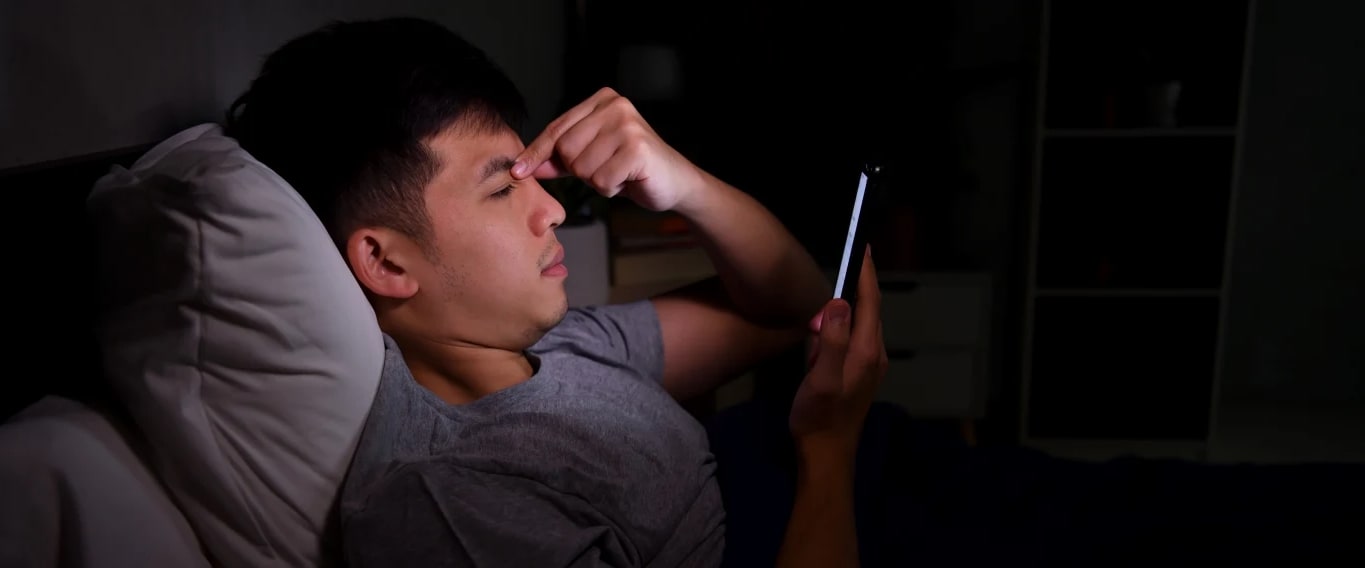The dangers of doomscrolling

At a glance
- Scrolling mindlessly activates the same physical reaction as addiction
- Doomscrolling can lead to anxiety, mood swings and insomnia
- Set time limits or redirect your energy before it becomes a problem
We’ve all done it — you start scrolling through social media and, next thing you know, an hour has passed and now you’re in a bad mood.
Social media is often flooded with upsetting content that brings down our mood or heightens our anxiety. Rather than turn it off, we continue to scroll. The phenomenon is known as “doomscrolling.”
As election season approaches and our feeds fill with tension-inducing content, take a moment to understand what doomscrolling is, why you may be drawn to it and how to avoid it.
Why do we doomscroll?
After a long day at work or school, scrolling on our phones is an easy way to de-stress, says Sandra McElliott, MA, MHP, clinical manager of adult outpatient services at Greater Lakes Mental Healthcare, a branch of MultiCare Behavioral Health.
But what starts as relaxing can quickly turn on you when you become addicted to your body’s reaction to scrolling.
“Addiction starts as something positive that activates the dopamine receptors,” McElliott says. “But then you’re constantly chasing that high, which doesn’t return.”
That “high” is a reward pathway, explains Jeff Eisen, MD, MBA, chief medical officer of MultiCare Behavioral Health. We’ve learned to use social media in ways that keep us coming back for more, but getting caught up in negative media is part of that, too, he warns.
“If it’s not managed in a reasonable way, it can become very challenging for people,” he says. “It can be utilized to escape tough experiences in your life, which is the same reason why people begin using substances, as well. But the question becomes: ‘What is the reward for doing so?’”
While many people use social media in positive ways, such as for entertainment or enjoyment, when used excessively — especially around online political activity — it can have the reverse effect.
Election season tension
“All throughout the year, you’re trying to sort out your personal views … and what you believe is important versus what you’re being told on social media,” Dr. Eisen says.
Then, election season hits and the media’s in overdrive. With so many viewpoints and an overabundance of inaccurate information, people may feel confused and question their beliefs, he adds.
It can be hard not to feel overwhelmed, says McElliott. You may go searching for the most accurate and unbiased information, but that can easily lead you down a rabbit hole on social media, she explains.
“You don’t set out with the intention of becoming addicted,” she adds. “It kind of sneaks up on you.”
Confirmation bias can play a role in why we doomscroll during election season, McElliott says. You may begin doomscrolling in search of content to justify your beliefs, which can become the reward your brain is seeking.
Change your approach
Rather than filling your free time with doomscrolling, redirect your energy.
Studies show that people who closely follow or participate in politics are more likely to doomscroll, Dr. Eisen says.
Even if engaging in politics is something that brings you joy, doomscrolling can have negative mental and physical impacts, such as anxiety, depression, trouble sleeping, high blood pressure, stomachaches or headaches, mood swings, eye and neck strains, or increased drug or alcohol use.
Bring your passion to the real world instead. Volunteer for a candidate or cause you feel strongly about, McElliott suggests.
If you enjoy the back-and-forth of political discourse, attend a debate or have those discussions with others in person, Dr. Eisen adds.
Build healthy screen habits
Having a healthy relationship with social media year-round is key to ensuring election season doesn’t wear you down.
- Set a limit on how much social media you consume, whether through timed scroll sessions or an allotted amount of screen time for the day. Or set rules around when you won’t scroll, such as first thing in the morning or right before bed.
- Filter what you see. You can follow, unfollow and block what you want when it comes to your social media feed. Filter out content or creators that don’t bring you joy, education or entertainment.
- Don’t forget the subliminal messages. It’s not just the in-your-face negativity that’s harmful. Much of what impacts our mental health is hidden and sometimes not noticed at all. Even if just skimming, your brain is still taking it in — so scroll with caution.
- Know your risk of forming an addiction. Some people may have predispositions, such as an addictive personality, obsessive compulsive disorder (OCD) or anxiety and/or depression, which could make it harder to stop doomscrolling. Speak with your friends, family or health care provider about your risk and how to spot the warning signs.
- Listen to those around you. If your friends or family notice you don’t put your phone down during dinner or seem distracted at social events, remember they’re saying that for a reason. They’ve noticed it enough to be concerned, so hear them out.
- If it’s interfering with your life, it may be time to reassess your phone usage. If you find yourself doomscrolling instead of working, spending time with others or participating in hobbies you once enjoyed, that may be a sign of a bigger problem. Use one of the many free tools available on most smartphones to track your usage and hold yourself accountable.
- Challenge yourself to switch to an activity that brings you joy or gets your body moving, such as reading a book or going on a walk, each time you catch yourself in a doomscroll.
- Be mindful, not mindless. Regularly check in with yourself and ask how the content you’re consuming makes you feel. If it’s making you agitated or anxious, turn it off. It’s about staying aware of what you’re doing. The more mindless you are, the harder it is to get out of it, Dr. Eisen says.
- Ask for help. If you or someone you know is struggling with social media consumption and it’s affecting your physical and emotional well-being, reach out to friends, family, your doctor, a counselor or any trusted person in your life.




